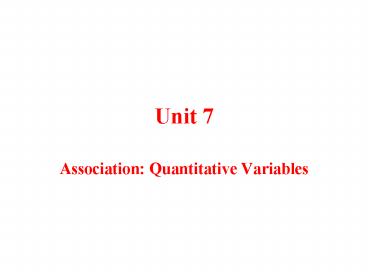Association: Quantitative Variables PowerPoint PPT Presentation
1 / 27
Title: Association: Quantitative Variables
1
Unit 7
- Association Quantitative Variables
2
Bivariate Data
- The study designs considered so far investigated
only one characteristic of a population. They are
single variable studies. - Many study designs aim to look for an association
between two quantitative variables measured on
the same subject. These are bivariate study
designs. The prefix bi means two.
3
Scatterpolts
- Scatterplots are the most useful graphical device
to examine the possible association between two
quantitative variables. - Scatterplots help us identify
- Trends
- Clusters
- Outliers
4
Constructing a Scatterplot
- A scatterplot is a two dimension display
- The data for one variable is plotted on the
horizontal axis and the data for the other
variable is plotted on the vertical axis. - The convention is to place the studied variable
(response variable) on the vertical (y-axis). The
variable that is used to do the predicting (the
explanatory variable) is placed on the horizontal
(x-axis).
5
Response and Explanatory Variables
- Some studies are conducted to predict the value
of one variable using the value of anther
associated variables. In these studies we can
identify response and explanatory variables. - Others are conducted to simply look for potential
associations between two bivariate variables. In
these studies the choice of response and
explanatory variables is arbitrary.
6
Examples
- Decide which variable is the response and
which is the explanatory variable - Serving size of an ice cream cone and the
calories of the ice cream cone - The gas mileage of an automobile and the weight
of the automobile - The price of a theatre ticket and the number of
ticket sales - The age at marriage of the women and the age at
marriage of the man
7
What to Look for in a Scatterplot
- Linear or straight line trends
- Non-linear or curved trends
- No obvious relationship
- Clusters
- Outliers
8
Linear Relationships
- A scatterplot of systolic blood pressure and age
for 29 subjects. Notice the points are not
exactly a straight line fit, but approximately a
straight line fit.
9
Non-Linear Relationships
- Monthly temperatures in Raleigh NC.
10
Positive and Negative Trends
- Two variables are said to have a positive (or
direct) association if larger values of one
variable occur with larger values of the other
variable - They are said to have a negative (or inverse)
association is smaller values of one variable
occur with larger values of the other variable
11
Examples
- Classify as a strong, weak or no association
- then if either strong or weak
- Classify as either a positive or negative
association
12
Classify Graph 1
13
Classify Graph 2
14
Classify Graph 3
15
Classify Graph 4
16
Classify Graph 5
17
Clusters
- The next interactive examines the concept of data
clusters - Unit A-7, Uses, Uses 1
18
Quantifying the Strength of a Quantitative
Association
- We have seen that associations can be
- Strong, weak or non-existent
- Positive or negative
- Linear or non-linear
- Now we want to measure the strength of linear
relationships
19
Correlation Coefficient
- The correlation coefficient, r, measures the
strength of a linear association - It is always the case that
- If r 1 then there is perfect positive
association - If r -1 then there is perfect negative
association - We only quote a correlation coefficient if
there is a linear relationship!
20
Computational Formula
- The computational formula for the sample
correlation coefficient is
21
Good News!
- Graphical and statistical calculators as well
as programs like Excel and MINITAB provide the
correlation coefficient as one of their options
when doing bivariate analysis
22
An Example
- Car Fuel Efficiency
23
Scatterplot for Fuel Efficiency
- Describe the association and estimate r
24
Results
- r -0.816
25
Association Does Not Mean Causation!
26
Results
- r -0.789
27
Question
- The Number of TVs per Person has a strong
negative correlation with Life Expectancy - Does this mean buying more TVs will increase
life expectancy? - Association does not mean Causation!

